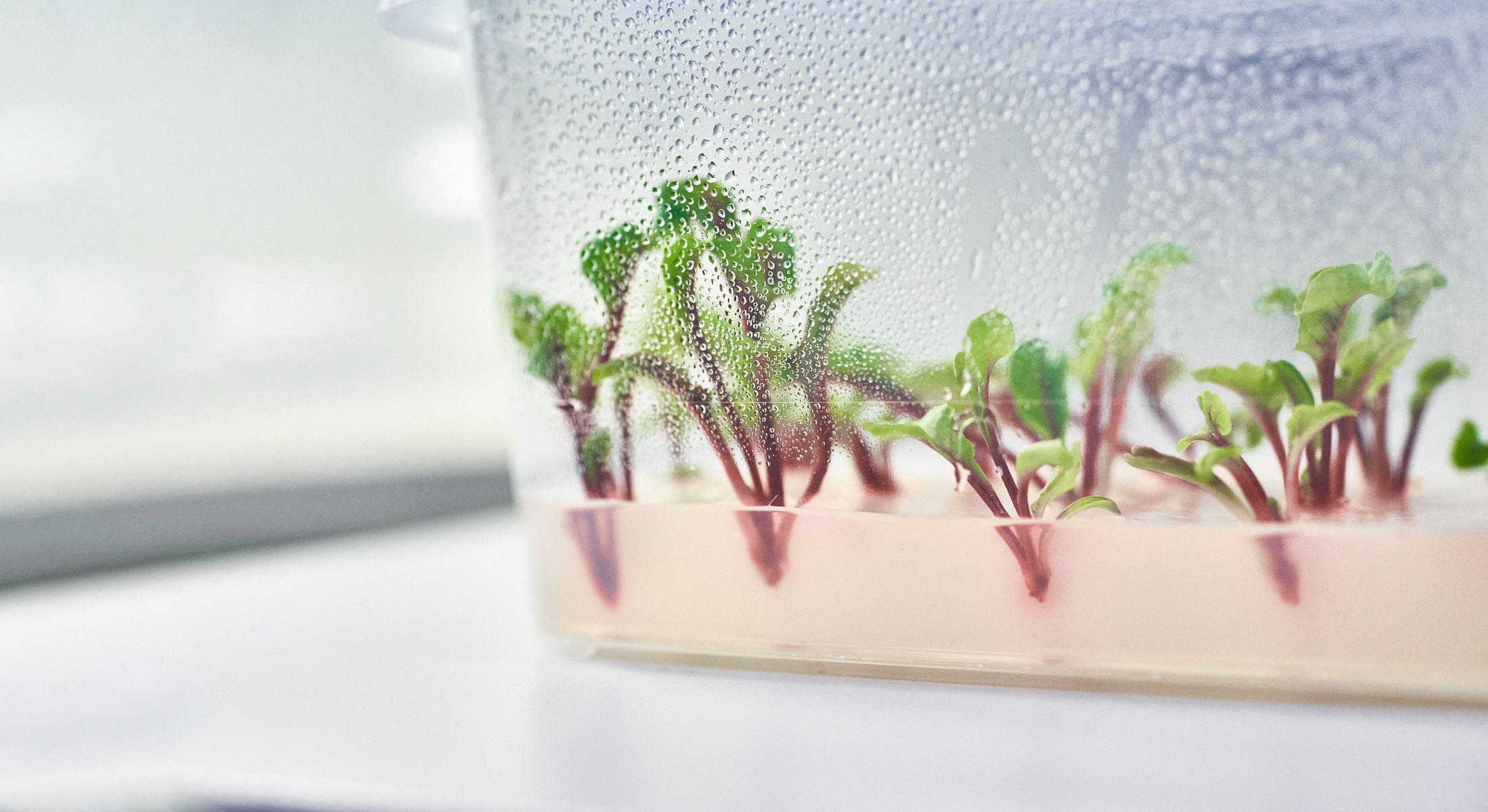Glossary on genome editing
A variant form of a gene at a particular locus on a chromosome. Different alleles produce variations in inherited characteristics.
Base editing is a genome editing method based on CRISPR/Cas9. It allows the targeted and directed conversion of one DNA or RNA base into another (i.e. the introduction of a point mutation) using DNA or RNA base editors. These base editors comprise a catalytically disabled nuclease fused to a catalytically active nucleobase deaminase enzyme.
A rod-shaped structure consisting of proteins and a strand of DNA, which usually carries many hundreds of genes. Different plants have different number of chromosomes: for example, sugarbeet has 18 chromosomes. Plants also vary in terms of ploidy, i.e., the number of sets of chromosomes.
Chromosomes usually reside in the nucleus of a cell. Besides nucleus, also the plants’ organelles (mitochondria and chloroplasts) contain DNA.
An adaptive component of bacterial and archaeal immune systems, used as a method of genome editing. CRISPR (Clustered Regularly Interspaced Short Palindromic Repeats) describes a segment of repetitive sequences separated by (foreign) viral DNA (called spacer). Proteins associated with CRISPR (Cas) use these specific sequences to protect the cell by finding and destroying viral DNA.
The organism from which genetic material is obtained for transfer to the recipient organism.
A change to the DNA sequence (e.g. insertion, deletion, substitution) at a specific site in the genome that is produced with targeted mutagenesis methods of genome editing and results in an intended effect (e.g. gene disruption).
A protein acting as a biological catalyst for chemical reactions.
A functional unit of heredity that is a segment of DNA in a specific part of a chromosome. A gene typically directs the formation of a protein or RNA molecule.
Germplasm (i.e. genetic material) within which sexual recombination is possible as a result of hybridization, including via methods such as embryo culture.
According to § 3 (3) GenTG, an organism, with the exception of humans whose genetic material has been modified in a way that does not occur under natural conditions by crossing or natural recombination. A genetically modified organism is also an organism that is used by crossing or natural recombination between genetically modified organisms or with one or more genetically modified organisms or by other types of multiplication of a genetically modified organism has emerged, provided that the genetic material of the organism has properties that are attributable to genetic engineering.
The complete DNA of an organism. Plant genomes are highly variable in size.
Umbrella term for methods that can change the genetic material of a living organism in a site-specific and in most cases targeted manner, typically with the aim of improving certain characteristics of a crop. The methods covered by this term use Cas-nucleases (i.e., CRISPR/Cas9, Base Editing, Prime Editing), Meganucleases, TALENs, ZFNs and ODM. Using these methods, it is possible to induce small nucleotide changes, deletions or precisely exchange entire genes. CRISPR/Cas-, TALENs-, ZFN- and ODM-based methods rely on DNA breaks which are repaired with or without the help of a repair template by the cell's own repair mechanism. Base Editors and Prime Editors directly convert nucleotides or rewrite sequences at the target site by utilizing additional enzymes.
The genetic constitution of an organism.
Short RNA segments used to direct the DNA cutting protein to the target location in the genome. gRNA segments contain a region with homology to the target sequence (usually 20 bases), and a sequence that interacts with the nuclease (e.g. Cas9).
Having different variants (alleles) of a specific gene on the homologous chromosomes of a cell or an organism.
Cell repair mechanism for DNA strand breaks, in which a repair template is used to “patch up” the DNA. The repair template must have great similarities with the cleavage sites of the DNA (homologies) to become inserted. HR is a more precise repair than NHEJ. In genome editing, the repair template is specifically designed and inserted; therefore, it is possible to replace a pathological gene with a healthy copy.
Having the same variant (allele) of a specific gene on homologous chromosomes of a cell or an organism.
A line that has been selfed to sufficient homozygosity to be considered homozygote.
Abbreviation for insertion and/or deletion. Describes the random removal or introduction of nucleotides in the DNA sequence. InDels occur when DNA double-strands are inaccurately repaired by NHEJ. This often leads to the disruption of the open reading frame and/or the creation of premature stop codons and therefore a loss of gene function.
The integration of a gene that consists of sequences from sexually compatible species, but which does not occur naturally in this constellation in the gene pool.
A type of enzyme that binds to and cuts specific DNA sequences. In genome editing, meganucleases can introduce changes both by non-homologous end joining (NHEJ) and by homology-directed repair (HR).
A change of an organism´s own DNA sequence. The change can be small (SNPs, small InDels) or can span thousands of base pairs (insertions, deletions, translocations, replacements) or can affect whole chromosomes but is limited to sequence variations within the gene pool (crossable species).
An enzyme that can cut through DNA or RNA strands.
Unintended effect on the genome and/or expression pattern, which may occur when a Genome Editing enzyme cuts DNA at a site in the genome that is similar to the intentionally targeted site.
Different observable characteristics of a trait within a species, which are produced by two or more alleles at a gene locus (genotype) and the interaction with the environment.
For example, flower colour is a trait, and red and white flower colours are two different phenotypes for the flower colour trait.
In nature, a plasmid is a small DNA molecule within a cell that is physically separated from chromosomal DNA and can replicate independently from genomic DNA. Plasmids are most commonly found as small circular, double-stranded DNA molecules in bacteria. In genetic engineering, isolated, artificial plasmids are widely used as vectors in molecular cloning.
Prime editing is a CRISPR/Cas9-based system that rewrites DNA to induce targeted and precise insertions, deletions, and base-to-base conversions. This method uses a prime editing guide RNA (pegRNA), a catalytically impaired Cas9 nuclease, and an engineered reverse transcriptase that initiates the precise change, addition or removal of a sequences. Once the new genetic material is incorporated into the cut strand of DNA, the prime editor nicks the unedited strand, signalling to the cell to rebuild it to match the edited strand.
Produced by joining two or more nucleic acid molecules by whatever means outside an organism capable of continued propagation after incorporation into an organism
A nucleic acid sequence used to direct cellular DNA repair pathways to incorporate specific DNA sequence changes at or near a target site.
A single-stranded molecule that transmits and regulates the DNA’s instructions for the development, functioning, and reproduction of all living organisms.
RNAi is a cellular mechanism that regulates gene expression by degradation of RNA molecules. It is triggered by doule-stranded RNA (dsRNA), that activate ribonucleases to target homologous RNA. RNAi processes can be used by researchers to block, or silence, the expression of a given gene.
Methods which induce double-strand breaks at specific and defined points of the genome by means of endonucleases. The DNA-binding domain can be either a protein or RNA. Methods that fall under this umbrella term are CRISPR/Cas, TALENs and ZFNs. SDN is subdivided into SDN-1, SDN-2 and SDN-3, depending on the degree of induced change.
The process of generating a mutation at a predefined location within a genome by using genome editing methods. The resulting mutation can be random (by using SDN-1) or specific (by using e.g., Base Editing, SDN-2 or SDN-3). Sequence insertions and replacements through targeted mutagenesis are limited to sequence variations within the gene pool (crossable species). The obtained changes could have been the result of traditional breeding or of a natural mutation.
A nucleic acid sequence subject to intentional binding, modification, or cleavage.
An observable (able to be seen or otherwise identified) characteristic of an organism. For example, flower colour is a trait.
An organism into whose genome sequences or entire genes of a sexually incompatible species have been introduced. These organisms are, in fact, genetically modified organisms (GMOs).
A distinct, uniform, stable genotype approved for its value for cultivation and use.
Discover more
Your contact




